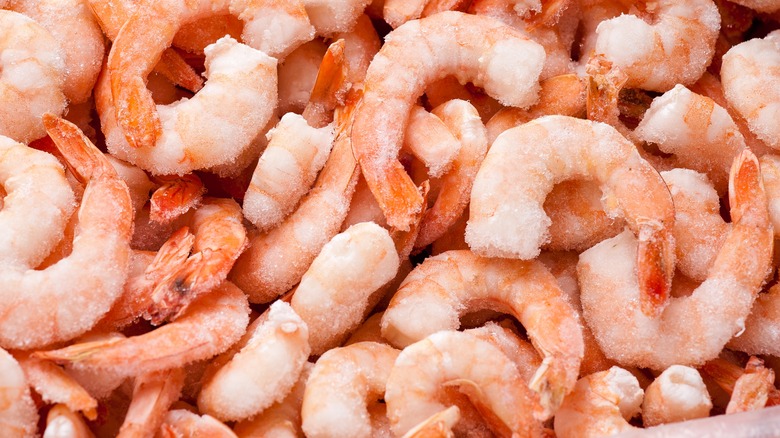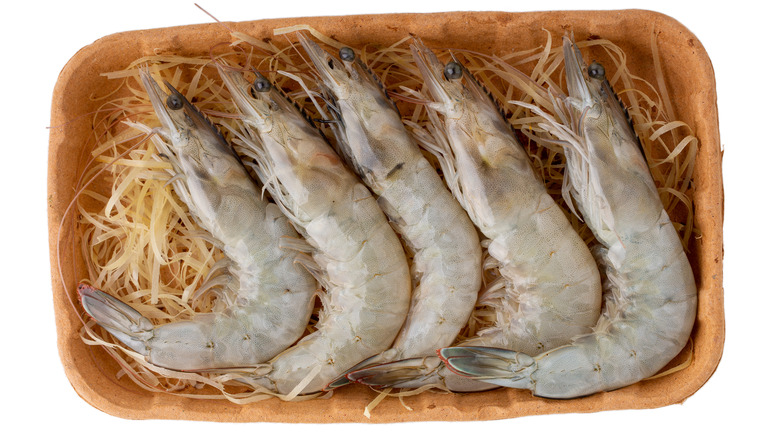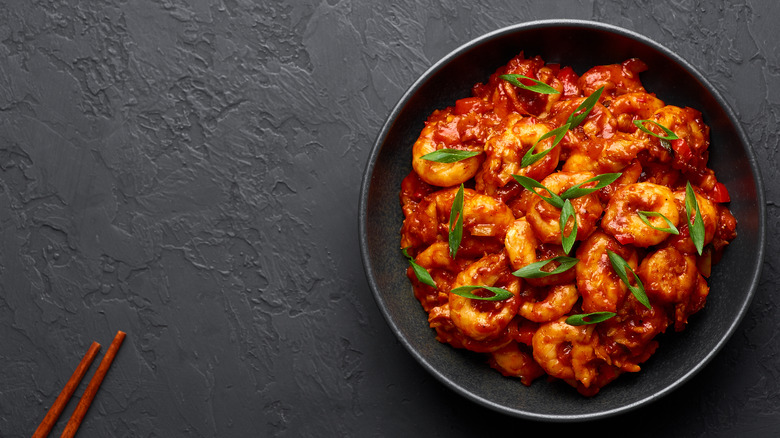You'll Find The Most Delicious Shrimp In This Section Of The Grocery Store
They often come to us without heads and shells, and they cook up into delightfully curled, plump pink morsels. So, what exactly are shrimp? According to Britannica, shrimp are crustaceans (like crabs and lobsters) that live in every world ocean and even in freshwater. National Oceanic and Atmospheric Administration (NOAA) Fisheries reports that we mainly eat three of the 2,000+ species: pink, white, and brown shrimp. Shrimp are the most widely-consumed seafood in the United States, NOAA adds — a nearly $500 million industry. Shrimp are also a mainstay of many marine predators' diets, including fish, crabs, and even barnacles, per American Oceans.
There's science behind our obsession with these brawny prawns: shrimp are high in protein, omega-3s, phosphorus, potassium, and magnesium, and they bring a colossal amount of iodine to the table (via Healthline). Due to their consumption of algae, shrimp also contain an antioxidant called astaxanthin, which may curb inflammation and boost brain and heart health, Healthline adds. Plus, they taste incredible. If you are craving shrimp as badly as we are now, here's where to find the best shrimp at the supermarket.
Skip the seafood counter
Head to the frozen seafood aisle for shrimp preserved at the peak of freshness. The Food and Agriculture Organization of the United Nations explains that shrimp can be frozen immediately after they're caught at sea, as opposed to fresh shrimp, which spoil very quickly. On each frozen shrimp bag, there's a number/letter combination. This indicates the shrimp count and size, according to American Shrimp. For example, 21/25 means there are 21-25 shrimp per pound, while a "U" and number means the shrimp total is less than or equal to the number. The smaller the number, the bigger the shrimp, says American Shrimp.
It's also preferable to purchase shrimp that are wild-caught, as shrimp farming threatens wildlife habitats, spreads diseases, and creates pollution, per World Wildlife Organization. Healthline also reports that imported farm-raised shrimp may contain antibiotics. Seek out responsibly-caught shrimp whenever possible, too. Commercial fishing methods produce bycatch, says Sustainable Fisheries — non-target species that may include dolphins, sea turtles, and even birds — which can be unfortunately killed as a result. American Shrimp also cautions consumers not to rely on words like "large" and "jumbo" because they're not regulated.
Don't skimp on the shrimp
So, you've got your big bag of frozen shrimp in hand. Now what? A classic shrimp scampi — originally made with langoustines, states The New York Times — makes an easy dinner and a beautiful presentation. You can also grill shrimp on skewers or stuff them in tacos. Taste Atlas names favorite preparations as diverse as Asian shrimp stir fry, Spanish and Mexican shrimp stews and rice dishes, and shrimp and grits from the Southern United States. Of course, you could always keep it simple with shrimp cocktail, per Food Network.
Cooking your shrimp with the shells on adds more flavor and nutrients to your dish, says American Shrimp. But don't discard the shells after cooking! American Shrimp adds that you can freeze them and use them to make seafood stock like Emeril Lagasse's. Shrimp is a healthy, delicious and versatile protein option to add to your culinary repertoire. NOAA reminds us that the average American eats 4.60 pounds a year, so that's all the permission the home cook needs.


